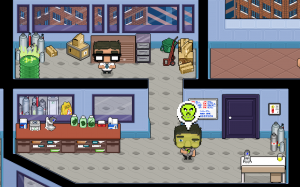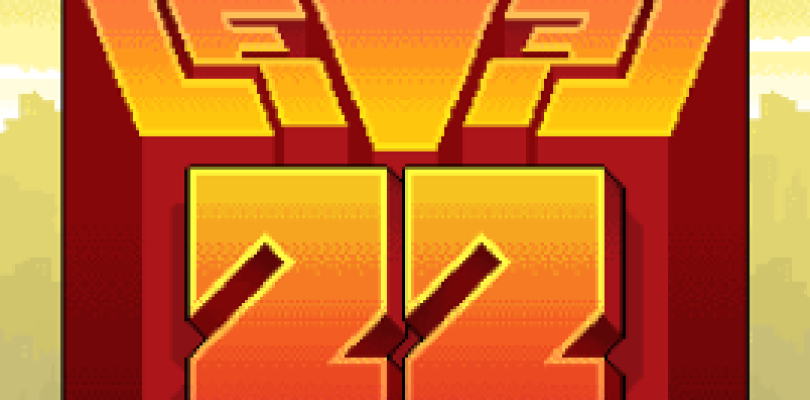There is something remarkably special about an audience looking upon your creation favorably to the extent that they allow the game to grow to its peak. Giving your audience the power and partial control over your project awards the fans by welcoming them as executive developers. This title grants them email and social network contact with the designers themselves, using it to advise and critique certain aspects of the project to, arguably, make the game better.
Noego Games are a French independent game developer who created Level 22: Gary’s Misadventures, a stealth puzzle game. This title is a great example of this trend due to its success on Desura and reaching most popular game on Steam’s Green Light. The title has been complemented by many, allowing the company to achieve 7th position in the stealth category for SlideDB’s mobile game awards.
The unique story focuses on the character Gary, whose primary goal is to avoid being caught sneaking into work late after a night a heavy alcohol consumption, under the assumption that being discovered will lead him straight to the back of the unemployment line. With help from Marty, you’re friend who just so happens to be the king of ‘goofing off’; you are able to navigate the environment with the mechanics he teaches you.
Proceeding through the twenty-two floors of office space allows you to find a range of different tools and objects. They are all used for the sole purpose of remaining unseen. For example, you can use a newspaper to avert the attention from yourself when hordes of workers approaching you or, to distract the more vigilant security guards you use a rather cliché donut. The challenge arises when you are forced to choose which prop to equip as you only have the ability to carry one. This often means scouting the level before attempting it.
Later on in the game, you are given the options to poison, expose to radiation or knock out employees allowing you to proceed. Although these are options, they are only occasional as the player relies heavily on what’s nearby to deal with the situations.
Another mechanic any good stealth game should use is vent crawling, which allows you to access areas of the level without being caught by employees. This can be extremely useful when you need to dive into cover when presented with a very limited set of options. In this sense, they are very similar to the filling cabinets you can leap into, which limit your vision but keep you hidden from enemies. These are both great for a short-term solution but finding the right time to leave them is the most important aspect.
The enemies are competent and have a good range of sight. Although they have a fixed path, it doesn’t stop them catching you hiding  behind a wall if they witness a quick glimpse of you. My only real fault with the enemies comes down to their lack of response to sound. With this implemented, it would increase the games difficulty and create caution within the player. Sound could be acted upon every time you walk through a door, crawl into a vent or maybe used by the player for distractions.
behind a wall if they witness a quick glimpse of you. My only real fault with the enemies comes down to their lack of response to sound. With this implemented, it would increase the games difficulty and create caution within the player. Sound could be acted upon every time you walk through a door, crawl into a vent or maybe used by the player for distractions.
The number of different looking workers is impressive. Never presenting you with the same employee twice on one floor demonstrates the level of detail that went into production. It gives the game the genuine feeling of diversity in an office setting.
The pixel art used achieves a retro feel and creates the foundations of the aesthetic. The majority of objects are square and the colour scheme practically continues throughout the game, achieving a mundane, depressing quality that lends itself to that feeling of dread approaching a terrible workplace. The offices strike a nice balance for the number of furnishings, giving the workplace a comfortable feel, nothing seeming out of place.
The music worked well with the flow of the game, often blending in with the game play, however, the lack of music was a problem. I often heard the same track several times in a session, which broke my immersion. As well as this, I felt adding dramatic effects would have been beneficial when meeting new enemies or coming close to discovery, adding that extra level of intimidation to being caught.
A personal gripe of mine regarding the music was that it was terribly off putting when trying to read the conversation between Gary and Marty. Ducking the sound would have been great as it would have allowed me to focus in on the writing, but as the game sound was the same in and out of conversation you can imagine just how distracting that can be.
The game is very challenging to say the least. The paths of employees are so complex in places that watching them is your only option. Once you were equipped with the knowledge of your co-workers locations you had the ability to progress, although this didn’t stop you running into further complications down the line.
The game suffers from its linear nature; often offering the player one route to follow and the props are handily dispersed in easy to access places. The title does a great job to disguise this, often taking you through a maze of vent shafts or using objects to tempt you further away from the exit; however, using your own path is satisfying and in the process, it can generate new mechanics, easter eggs or side objectives.
Level 22 has everything that makes a great stealth experience in an unconventional setting, allowing it to be recognized as a unique concept. Giving the player access to a wide choice of props keeps the game interesting; whilst passing through the deliberately dull levels but the game does has some minor issues. Although the game does a great job, little aspects affect the fluidity of the game play for me like the lack player sound or the linear level progression. These are all very subjective issues and many of you will disagree with the points raised, but due to the games successful attempt to produce something great, I am forced to raise small points.
This title is available on Steam for £4.07, Desura for £3.49 and on the Appstore for £1.49 on sale.

